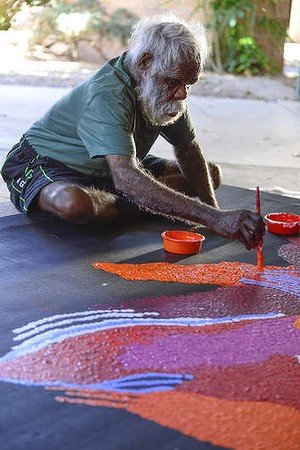YANNIMA TOMMY WATSON
BIOGRAPHY

Image: Blairhe
Pitjantjatjara elder Tommy Watson has gained wide domestic and international exposure in an astonishingly short amount of time. Since beginning his artistic career in 2001 his paintings have been greeted with instant acclaim. His first works were created at the community arts centre in Irrunytju, also named Wingellina, located 12kms south west of the tri-border, where the Northern Territory, Western Australia and South Australia meet and 720 kms. south west of Alice Springs, on the edge of the Great Victoria Desert.
His debut at the 2002 Desert Mob show in Alice Springs was followed by a series of domestic group exhibitions, as Watson’s reputation gained momentum. However the sale of a major painting for $36,300 in an auction organised in 2003 to raise money for the struggling art centre created a frenzy about his work. The catalogue for the sale was distributed widely amongst collectors and, since that time the demand for his works has always outstripped supply. On learning of the sale, Tommy Watson and his entourage travelled to Alice Springs and painted 42 works for Red Sand Gallery before entering in to a representative relationship with art dealer, John Iannou, owner of Agathon Gallery for whom he pas painted ever since. In as much as this exclusive arrangement represented a breakaway from established the avenue of representation though Community Art Centres, it has been the subject of much controversy. However, the calibre of work that Watson has consistently produced under the care of Iannou – even, the fact that Watson still does paint, after a period of retreat – is a testimony to the success of their working relationship. Other artists working at Irrunytju were obviously impressed as, before long, Iannou took over responsibly for the art centre itself and has controlled the community art output ever since.
Tommy Watson’s prominence was ultimately cemented when, in 2006,he was commissioned to create a permanent installation in the Paris Musee du Quai Branly. The piece he created, ‘Wipu Rockhole’, was converted into a ceiling mural made using baked enamel on stainless steel. It presents a radical transposition in medium, as a traditional painting embedded in architecture.
To outline the rise and rise of Tommy Watson would chronologically, read almost as a ‘how to’, a kind of study in crossing the threshold from ‘next big thing’ to ‘the hot thing’. Yet the transition was actually far from contrived, or even self -driven. This is perhaps why the description of art star is so incongruous when applied to Watson. He prefers not to enter into art dialogue at all, a fact that is helped by his almost total reliance on his first language, Pitjantjatjara. The sense of great expectation surrounding Tommy Watson would present a challenge to any artist labelled in such a way. Yet Watson, still living out the traditional indigenous culture that he records in his paintings, remains impervious to hype. He is motivated by a desire to express something from deep within, a notion that lies completely beyond the market for his art. This philosophy of transcendence is reflected in Watson’s paintings and makes the best of them truly great works of art.
His rising status can ultimately be attributed to the quality of his work, for it is the work itself, which provides the key to Watson’s internal world. Other painters from this geographic region, the Spinifex people, have recorded in their paintings the effect of the British nuclear testing in this country during the 1950’s in a somewhat similar manner to how Watson expresses the history of the land in his own work. Grounded in his paintings are rockholes, mountain ranges, and creekbeds. However we see these transmitted in waves of light. Some of his paintings are obliquely evocative of nuclear shock waves, light waves, and explosions. These highly charged coloured canvasses are studies in movement and light. They meet the dual demand of the contemporary Indigenous Australian art market in that they tend towards abstract expressionism as well as conforming to the traditional working techniques, of layering and ‘dotting’.
What we see manifest in Watson’s paintings seems to shift and shimmer out of description. They have been described as incandescent, an interesting and possibly revealing use of a term defined as shining or ‘glowing with heat’. Circular perhaps, because ‘hot’ is the term that, again and again, is used to describe the artist himself.
© Adrian Newstead
References
Ryan, Judith. Colour Power (2004), National Gallery of Victoria, Melbourne.
McDonald, John. ‘Man of the Moment’. The Financial Review Magazine, June 30, 2006.
Artist’s profile: Watson, Yannima (Tommy). Agathon Gallery website.

